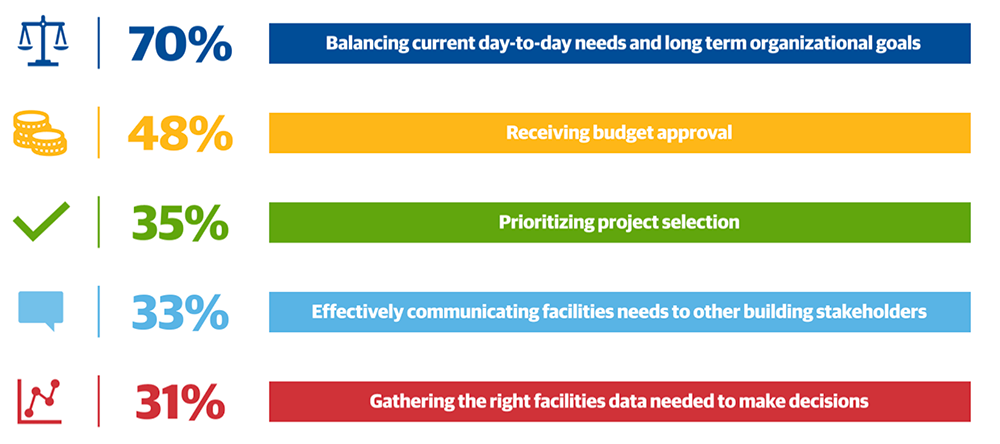SPONSORED
Gordian - Branded Feature
Feeling Uncertain About Capital Planning? Start with an FCA
By far, facilities capital planning is one of the most important and one of the most complex exercises an organization engages in. It’s an assignment fraught with uncertainty. In fact, a Gordian-sponsored survey of facilities leaders revealed just how daunting those tasked with facility capital planning find the process to be.
- 70% of respondents told us they are challenged to balance day-to-day needs with long-term organizational goals.
- 48% struggle to achieve budget approval.
- 35% have difficulty prioritizing projects.
- 33% say that have difficulty communicating facilities needs to other stakeholders.
- 31% are challenged to gather the data to make informed decisions.

If you zoom out from these survey results, you see a crisis of confidence. Facilities leaders feel unsure they have the tools they need to successfully create a multi-year facility capital plan. One way organizations can bridge this confidence gap, enter the planning processes on surer footing and make smart long-term decisions is to conduct a facility condition assessment or FCA.
What is a Facility Condition Assessment?
At its core, an FCA is a technical assessment that measures the condition and functionality of all the assets in an organization’s facilities portfolio. This assessment is largely concerned with major building systems – think HVAC, plumbing and electrical – but it includes all physical components from the foundation to the roof and everything in between. An FCA is a detailed inventory of everything, including facilities infrastructure and any other physical assets that require funding to maintain.
How a Facility Condition Assessment Aids in Capital Planning
A thorough FCA results in a wealth of facilities data. In addition to an assessment of the condition of every individual building component and system in the facilities portfolio, an FCA will include details about repairs and replacements to help establish accurate cost estimates for defined capital renewal and replacement projects. An FCA is like a checkup for facilities. Assessors evaluate the component parts of a building, report on their condition, and recommend what to do about areas where conditions are deteriorating – including the financial exposures and physical safety risks involved in standing pat. Owners then dig into the data collected from the FCA – the facilities diagnosis, to continue the metaphor – and use it to chart a path forward via a facilities capital plan.
Recall that our survey results show that facilities leaders think they do not have the data they need to make informed capital investment decisions. An FCA supplies that data and gives facilities leaders a starting point from which they can build capital plans.
The truth is that capital planning can be an emotional, often political, exercise. Every facility is someone’s favorite, an asset they view as key to the future success of the organization. As a result, conversations about investing or divesting in facilities can get strained, heated even. An FCA helps lower the temperature during the capital planning process with objective data about which facilities are performing well, which facilities could benefit the organization with the proper financial investment and which facilities should be decommissioned or replaced for the greater good.
An FCA doesn’t play favorites. What it does do is give planning teams the data they need to demonstrate a need for more funding and route facilities capital investments to the places where they will make the greatest impact.
In-House or Third Party: Best Practices for Conducting Facility Condition Assessment
Assessing every building system, asset and component is a phenomenal amount of work. Thus, thorough and accurate facility condition assessments take a lot of time and know-how to complete. And while an organization’s in-house facilities staff may have the expertise to conduct an FCA, they have a lot of responsibilities already. Adding more to their workload is a recipe for burning them out and potentially ending up with an incomplete portfolio assessment that will hinder the planning process. In the end, burdening an in-house team with conducting an FCA is a good way to leave everyone unsatisfied.
That’s why the best way to collect FCA data is to work with an industry partner with a proven track record of documenting facilities needs and defining project priorities. Look for partners that offer various assessment options so you can choose the right one for your organization, and assessors with years of experience and specific areas of expertise.
As always, engaging with an industry partner will be more expensive than deploying existing staff to do the work. But you don’t want to cut corners when it comes to an FCA. There’s too much at stake. By the end of the assessment, you’ll want to have a comprehensive view of your facilities portfolio and the data you need to build an informed multi-year capital plan.
Facility Condition Assessments: The Foundation for an Informed Capital Plan
Long-term facility capital planning is conceptually similar to retirement planning in the sense that you can’t reach your goals without a clear understanding of your current assets. Such an understanding takes data in the form of financial accounts and, often, the help of an advisor. It helps to take the same approach to facilities capital planning.
Knowing your facility portfolio’s financial risks and safety concerns is the first step to making decisions about your organization’s future so you can achieve your long-term goals. A facility condition assessment conducted by an experienced partner lays the foundation for informed planning discussions and, ultimately, a sustainable capital plan your organization can be confident in.









